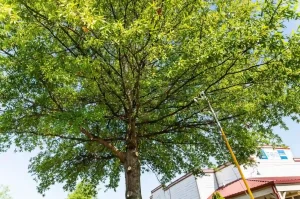In arboriculture, trimming large tree branches is an art requiring attention to detail and understanding tree biology. As we care for trees, it’s crucial to prune branches thoughtfully for health and aesthetics. By exploring How to Safely Trim Large Tree Branches and ‘Designing Harmony, you can harmonize tree maintenance with natural beauty.
Key Takeaways
- Conduct a thorough risk assessment before trimming large tree branches.
- Use the appropriate tools and equipment, such as pruning shears and safety gear, for safe trimming.
- Follow proper techniques like starting from the bottom and using the Three-Cut Technique to avoid damage.
- Implement safety measures like wearing PPE, inspecting the tree for damage, and having a clear trimming plan.
Understanding the Risks
Understanding the risks associated with trimming large tree branches is crucial for ensuring the safety of both individuals and property during the process. When embarking on such a task, one of the primary risks to consider is the potential for falling branches. Large branches can be heavy and unpredictable, posing a significant danger to anyone standing below.
Additionally, working at heights to trim branches increases the risk of falls, leading to severe injuries or even fatalities. Another risk is the possibility of branches getting entangled in power lines, which can result in electrocution or fires.
Moreover, improper equipment or techniques can lead to accidents, causing harm to individuals and property. It is vital to assess these risks thoroughly before starting any trimming activities and to take appropriate safety measures, such as wearing protective gear, using the right tools, and having a spotter on the ground for assistance.
Essential Tools and Equipment
Assessing the risks associated with trimming large tree branches underscores the critical importance of having the appropriate tools and equipment for the task at hand.
To safely trim large tree branches, several essential tools are required. Firstly, a reliable pair of sharp pruning shears is necessary for cutting smaller branches with precision. For larger branches, a pruning saw with a sharp blade designed for cutting wood is indispensable. Additionally, a sturdy ladder that can reach the desired height safely is essential for accessing higher branches.
Safety equipment such as gloves, goggles, and a helmet should always be worn to protect against potential hazards like falling debris. A rope and harness system can provide extra security when working on taller trees. Lastly, a wheelbarrow or tarp can be used to transport branches and debris away from the work area efficiently.
Proper Techniques for Branch Trimming
Implementing proper techniques for branch trimming is essential to ensure the safety of both the pruner and the tree. When engaging in this task, it is crucial to follow these key practices:
- Start from the Bottom: Begin trimming branches from the bottom of the tree and work your way up. This method helps maintain balance and stability.
- Use the Three-Cut Technique: Make the first cut underneath the branch, a few inches out from the trunk. The second cut should be outside the first, cutting all the way through. The final cut removes the remaining stub.
- Avoid Tearing Bark: To prevent damaging the tree, always cut branches cleanly and avoid tearing the bark. This helps the tree heal properly.
- Mind Branch Collar: Identify the branch collar – the swollen area where the branch meets the trunk – and cut just outside this area to promote healing and prevent disease.

Safety Measures and Precautions
When it comes to ensuring the safe and effective trimming of large tree branches, incorporating proper safety measures and precautions is paramount for both the pruner’s well-being and the tree’s health.
Before embarking on any trimming activities, it is essential to wear appropriate personal protective equipment (PPE) such as gloves, eye protection, and a helmet to shield yourself from any potential hazards like falling debris or branches. Additionally, inspecting the tree for any signs of damage, decay, or instability is crucial to identify potential risks that could pose a danger during the trimming process.
Furthermore, using the right tools for the job, such as sharp and well-maintained pruning shears, loppers, or a handsaw, can help prevent accidents caused by tools malfunctioning. It is also advisable to have a clear plan of action before starting the trimming process, including identifying the branches to be removed and the direction in which they should fall to avoid any obstacles.
Aftercare and Maintenance
Proper post-trimming care and maintenance are essential to ensure the tree’s health and promote optimal regrowth. After trimming large tree branches, follow these key steps for effective aftercare and maintenance:
- Monitor Wound Healing: Regularly check the trimmed areas for any signs of infection or decay. Keeping an eye on the healing process will help address any issues promptly.
- Mulching: Apply a layer of organic mulch around the base of the tree to retain moisture, regulate soil temperature, and provide essential nutrients for new growth.
- Pruning Sealant: Consider using a pruning sealant on larger cuts to protect the exposed wood from pests and diseases while promoting faster healing.
- Regular Watering: Maintain a consistent watering schedule, especially during dry periods, to support the tree in recovering from the pruning stress and encourage healthy regrowth.
Frequently Asked Questions
Can I Trim Large Tree Branches on My Own, or Should I Hire a Professional?
Trimming large tree branches requires careful consideration. While some may opt for a DIY approach, hiring a professional arborist ensures safety and precision. Professionals possess the expertise and equipment necessary to execute the task effectively and maintain tree health.
Are There Any Specific Regulations or Permits Required for Trimming Large Tree Branches in My Area?
Certain areas may have regulations or permit requirements for trimming large tree branches. It is advisable to consult local authorities or a certified arborist to ensure compliance with any specific rules governing tree maintenance in your area.
What Are Some Signs That Indicate a Tree Branch Is Unsafe and Needs to Be Trimmed?
Indications of an unsafe tree branch include dead or diseased sections, cracks, splits, or significant leaning. Regularly inspect trees for these signs to identify branches that require trimming to enhance safety and prevent potential hazards.
How Often Should I Trim Large Tree Branches to Ensure the Health and Safety of the Tree?
Regularly trimming large tree branches is essential for tree health and safety. It is recommended to trim every 3-5 years, but factors like tree type, growth rate, and branch condition should be considered. Consulting an arborist can provide tailored advice.
Are There Any Alternative Methods for Trimming Large Tree Branches That May Be Less Common but Still Effective?
Alternative methods for trimming large tree branches, though less common, can be effective. Consider techniques like crown lifting, drop-crotching, or pollarding. Always consult a certified arborist for guidance to ensure the health and safety of your trees.
Conclusion
In conclusion, mastering the art of safely trimming large tree branches requires a combination of knowledge, precision, and the use of proper tools and techniques. By understanding the risks involved, selecting the right equipment, implementing correct cutting methods, and following safety precautions, individuals can effectively maintain tree health and aesthetics. Consistent aftercare and maintenance practices will ensure the longevity and beauty of trees, promoting a harmonious balance between landscaping and environmental conservation.
You May Also Like:

